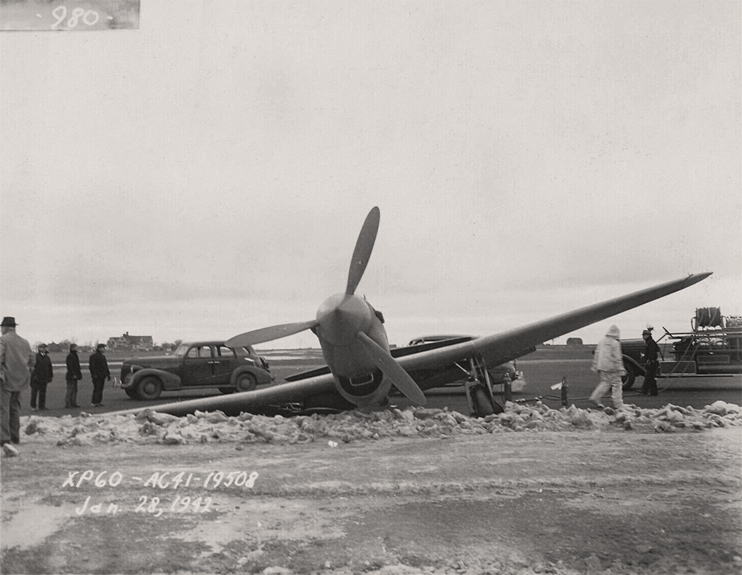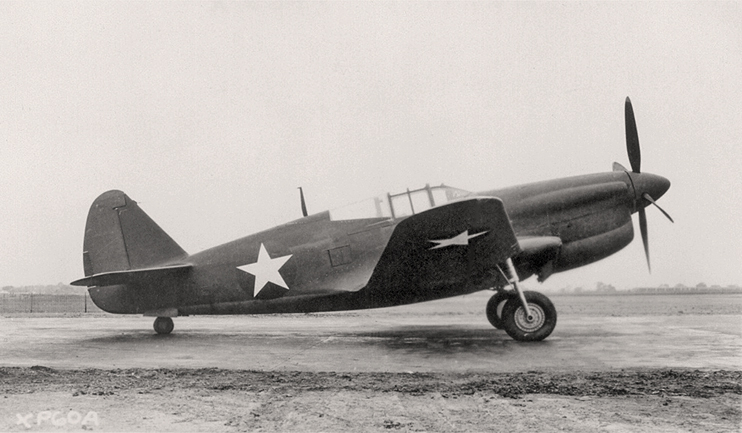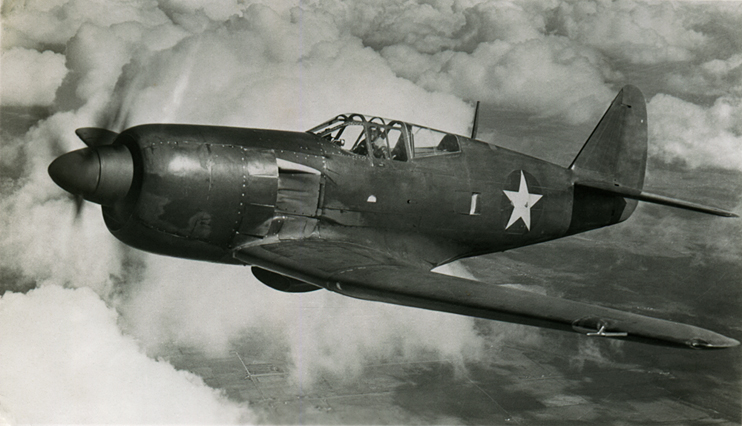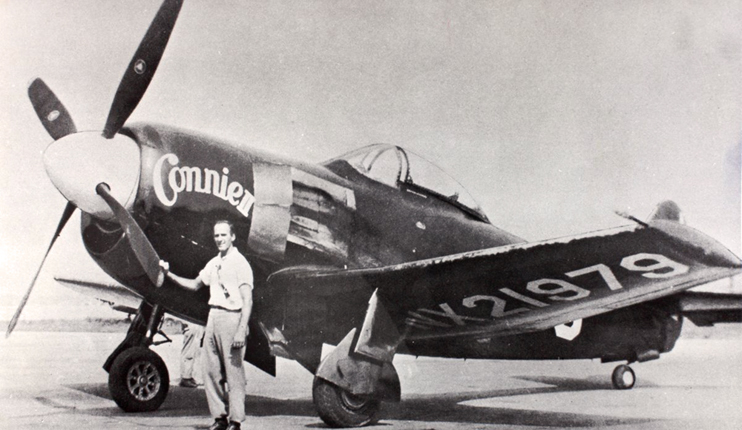Curtiss XP-60
For more information concerning the convoluted P-60 project, take
a looksee HERE
for the late, great Joe Baugher's writings on the subject.
XP-60 41-19508
The XP-60 in original configuration, with a standard P-40 tail assembly. This
was the second of two airframes that had initially been constructed for the P-53
project. She was initially powered by a British-built Rolls Royce Merlin 28,
but this was later switched out with a Packard-built Merlin V-1650-1.
The XP-60 first flew on September 18th, 1941, with disappointing results.

Project 914 Archives -
Larger Image
During early test flights, stability problems lead to a redesigned tail assembly.
This first photo is dated November 3rd, 1941...

Project 914 Archives (S.Donacik collection) -
Larger Image
...and this one, November 19th, 1941.

Project 914 Archives (S.Donacik collection) -
Larger Image
These two photos were taken on January 28th, 1942 after one of two landing gear
failures during early testing. This first shot shows that further modifications
had been made to the vertical tail, notably the enlarged rudder balance.

Project 914 Archives -
Larger Image

Project 914 Archives -
Larger Image
The XP-60 was later rebuilt as the XP-60D. She was destroyed on May 6th, 1943 after the
tail came off in-flight near Alden, New York. The pilot, Don Armstrong, bailed out.
I currently have no images showing the ship configured as the XP-60D, but hope to find
some eventually. If and when that happens, I'll add them to this page, pronto...
XP-60A 42-79423
With the XP-60A came a nearly wholesale redesign of the fuselage, especially up front.
The new cowling was designed to accomodate the change of powerplant from the British-built
Merlin 28 to an Allison V-1710-75 paired with a General Electric B-14 turbo-supercharger.
She first flew on November 11th, 1942 and, again, the results were disappointing.
The ship was dismantled and various parts were used for the XP-60C and XP-60E.

Project 914 Archives -
Larger Image

Project 914 Archives -
Larger Image
Though the lackluster performance of the XP-60A caused the Army's interest in the type to wane,
Curtiss all but promised much better performance from subsequent prototypes, rekindling the
Army's interest. As result, an order for 500 P-60As was placed, twenty-six of which would be
YP-60A service test models. After the proposed prototypes were built and continued to yield
poor results, the Army altered the contract, reducing the order to just two YP-60As.
XP-60C 42-79424
Originally slated for installation of a Chrysler XIV-2220 in a cowling similar to that of
the XP-60A and B, problems with that experimental engine saw the USAAF order Curtiss
to use a Pratt & Whitney R-2800-53 instead, forcing yet another substantial redesign. This
resulted in what your webmaster considers to be much more pleasant lines, though the twin
three-bladed contra-rotating props gave the ship something of a wonky appearance when
viewed from certain angles, partly negating the aforementioned aesthetic pleasantness.
She first flew on January 27th, 1943 with mediocre results.

San Diego Air and Space Museum (Ray Wagner Collection) -
Larger Image

Project 914 Archives (S.Donacik collection) -
Larger Image

Project 914 Archives (S.Donacik collection) -
Larger Image
XP-60E 42-79425
Originally constructed as the XP-60B, similar in appearance to the XP-60A and with
the same powerplant but with a Wright supercharger instead of the G.E. unit, this ship
never flew in that configuration. Instead she was equipped with a P&W R-2800-10, giving
her a similar appearance to the XP-60C. The more conventional four-bladed prop fitted
was naturally lighter than the twin contra-rotating jobs of the XP-60C, and so the engine
had to be moved forward about ten inches. In this configuration she became the penultimate
member of the P-60 family. Unfortunately the XP-60E proved to be more troublesome than
her near-twin XP-60C, with pilots reporting difficult and twitchy handling characteristics.
Not that it mattered, though. The P-60 project was by this time an entirely lost cause,
with Curtiss continuing development despite the AAF's total loss of interest.

Project 914 Archives -
Larger Image
I've so far not found any info about this forced-landing.

Project 914 Archives -
Larger Image
YP-60E 43-32763
One reason Curtiss continued development was that, despite the AAF's loss of interest in
the P-60, there was nonetheless still a contract for Curtiss to build two YP-60As. By May
of 1944, though two YP-60As were under construction, Curtiss was finally ready to give up
the ghost with the P-60 and requested that they be allowed to cease all work on the project.
The AAF said 'nu-uh', and insisted that Curtiss complete at least one of the ships already
under construction. The result was the YP-60E, so-designated because of the many advances
and improvements made in the prototypes constructed subsequent to commencement of the
P-60A contract; most of which were embodied in the XP-60E. The YP-60E was indeed and
by far the most advanced member of the P-60 family, but still fell far short of other
fighters (namely the P-47 and P-51) already in widespread service.
This ship flew for the first time on July 13th, 1944 and was flown just once more by Curtiss
before going to the Army at Wright Field. No significant trials were conducted, however, as
the Army simply had no need for the aircraft. She was disposed of as surplus at war's end.

Project 914 Archives -
Larger Image
And the fella who bought the YP-60E was Jimmy DeSanto, who planned to run her in the 1947
National Air Races. Decked out with the race number '80' and named 'Connie II', the ship
developed trouble during a qualifier and was destroyed after DeSanto bailed out.

San Diego Air and Space Museum (Charles M. Daniels Collection) -
Larger Image
Back to 'Other Curtiss Aircraft'









